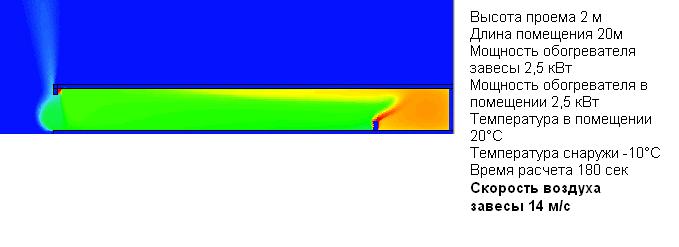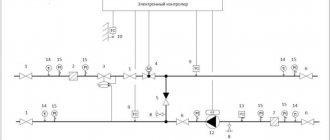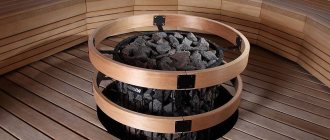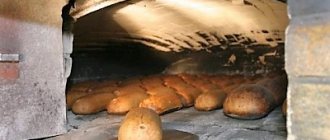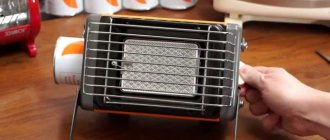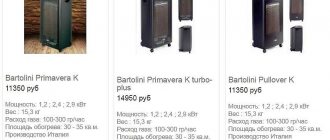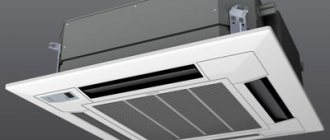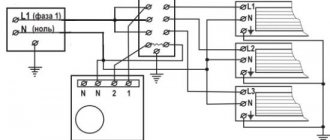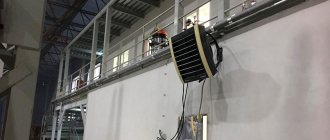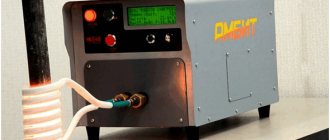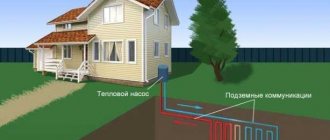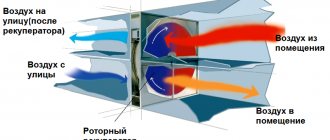It is unpleasant when cold air enters a warm house and cools it down. However, this problem can be easily solved. In order to maintain the optimum indoor temperature, thermal curtains have been developed. This equipment will help prevent warm air from escaping to the outside and keep the cold from getting inside. Such a system serves as a barrier separating the house and the outside space with the help of an air jet that is supplied automatically.
You can not be afraid of the cold if you install curtains.
Main characteristics
There are systems that operate on various heat sources. There are electrical and water curtains. The second type is more economical to use, since heating occurs at the expense of hot water.
Such equipment has many advantages, including:
- Reliable protection of the premises from heat loss.
- Creation of a special barrier that does not allow dust, various insects and exhaust gases to enter the house.
- Preventing cold air from entering the house.
- Temperature optimization.
- Additional heating.
- The ability to keep the door open in the house.
- Creates a cool and comfortable temperature in hot summer conditions.
- Profitability.
Main element
The main component of the design is the central fan. This element must be located along the entire length of the system and be uniform in order to create an even flow. The motor is located on the side of the fan.
However, some manufacturers place the engine in the center and small turbines on the sides. The reason for this decision is the difficulty of creating a full-fledged element of the required length. Such a water air-heat curtain has a more affordable cost, however, its protective properties will not be enough. The air flow will feel a "dip" in the center. Moreover, the heating elements will be blown unevenly, which will significantly reduce the service life of the equipment.
Heating methods
According to the heating method, thermal curtains are mainly subdivided into electric and water curtains.
In the former, almost all electrical power is used to heat the air. In the second case, the heating power is usually many tens of times higher than the electrical power used to create an air flow.
In air curtains with water heating or in air curtains without heating, the power is fully used to create an air flow. For these devices, the efficiency of converting power to air flow or efficiency is of particular importance. creating an air flow.
Equipment management
The system must have at least two switches, one of which is responsible for the heating elements, and the other for the fan. In addition, the heating power regulator can be installed, which includes two or three switching levels. The fans can run at two speeds. The curtain has a thermostat that automatically turns off the heating elements when the programmed temperature is reached.
There are wired and built-in consoles to control the system. The variety depends on the specific model. The built-in type is used for small curtains installed for doors and windows. This is due to the fact that in this case the user will simply reach the buttons.
In some situations, it makes sense to install a limit switch that allows the system to start only when the door is open. It is especially useful in a hangar or warehouse.
What are the air curtains
By type of installation:
- Vertical. Installed on the side of the opening.
- Horizontal. Installed on top of the opening.
- Universal. Installation is possible both at the top and at the side of the opening.
By type of coolant:
- Electrical. They work on the basis of heating elements, which are heated to the desired temperature by electricity. Relevant if you need to separate the interior and exterior space.
- Water. They are more difficult to install, but more economical to operate, especially with high capacities, since water tariffs are still lower than electricity tariffs. The heat source in this case is steam generated from hot water coming from the central heating system. In this case, the water flow can be adjusted. Usually such curtains are used on an industrial scale.
- Without heating. They are used in well-heated premises, where it is necessary to maintain the internal climate. Such a curtain is very economical, especially when the load on the power grid is limited, and its compact size makes it possible to install this type of equipment even on suspended ceilings.
In addition, you can find the classification of air curtains by power and size:
- Mini curtains. Designed for small openings such as windows or kiosks.
- Medium curtains. As a rule, they are installed above small openings up to three meters high, which allows to reduce heat loss when the doors are open and to prevent cold drafts.
- Large curtains. Used to protect small industrial openings. Basically, these are medium-sized gates up to 7 m high.
- Heavy duty curtains. Used to protect openings up to 12 m high.
Choice of design
There are many factors to consider when choosing the right system. Including:
- Performance. It directly affects the air flow rate as well as the installation height of the equipment. For example, for a door with a height of 2 meters and a width of 1 meter, a curtain with a "pumping" of 700-900 cubic meters / hour is suitable. The cost of such equipment will be quite high. For installation in small openings, systems with a lower performance are purchased. Since such structures are most often used in industrial premises, one should not save on this factor, otherwise the system will be ineffective.
- Power. As an example for the calculation, we can give a room of 10 meters squared with a ceiling height of 3 meters. In this case, the power should be - 1 kW. However, in such a situation, the building must be thermally insulated. For well heated areas, you do not need to choose a high power system. It is worth remembering that the air leaving the system will not be hot even at the highest power. Its temperature is always warm, since the heating elements blow at a high speed.
- Length. It can be from 60 cm to 2 meters. The most popular length is 80 cm-1 meter. Such systems are mounted above the door, therefore they are not suitable for industrial purposes. In order to select effective equipment, you need to choose structures with a length equal to the width of the opening or slightly more.
Limited efficiency

Room temperature without air curtain


Room temperature with air curtain
A working air curtain prevents this alignment, although it is unable to completely resist the transfer of matter through the opening.
Moreover, if the device has excessive characteristics in terms of the air flow rate, then its action will contribute not to the separation of temperatures or other characteristics of the media, but to their faster equalization on different sides of the opening - in this case, the curtain will become useless.
Any real air curtain cannot completely separate the media and, in the best cases, have an efficiency of no more than 70-75%.This is due not to a flaw in their design, but to physical principles: even for small openings with heights of 1-2 meters and air flow velocities of several meters per second, the jets of the devices are turbulent. And any turbulent jet implies the movement of matter not only along, but also across its main flow.
If we assume that when the opening height is less than 1 cm and the air velocity is less than 1 cm / s, the air curtain flow will become laminar. This implies the theoretical possibility of 100% efficiency, that is, complete separation of the media on different sides of this opening).
Heat curtain market
There are many types of equipment.
The following manufacturers are popular on the Russian market:
- Ballu (international company). They produce products with minimal energy consumption. Both horizontal and vertical models are presented.
- Frico (Sweden). The systems have a remarkable design, reliability and high build quality.
- Tropic Line (Russian company). The equipment is highly efficient and affordable. The main specialization is household thermal curtains, however, there are several types of industrial models.
- Teplomash (domestic manufacturer). Produces quality equipment at affordable prices.
Installation of a thermal curtain
It is better to entrust the installation of this equipment to professional workers. Only they are able to carry out the installation efficiently and make the connection of the heat curtain reliable. Usually the firms that carry out these devices also offer installation services.
The master will always initially carry out verification work, inspect the curtain for integrity and for compliance with the configuration (the kit must include brackets that allow directing air flows). Devices can be installed in two ways - horizontally and vertically.
The device comes with a flexible cable, and there is also a plug equipped with an earthing connection. When making a fixed connection (without using a plug), work must be carried out through a central switch with an air gap, with a value of more than three millimeters. The connection of this heat curtain can only be carried out by a professional electrician, subject to all the necessary rules.
During installation, special wires are used. In the area where the cable is inserted into the device, special sealing rings are taken, which are necessary for good protection.
Before connecting the device, it is necessary to establish the correct operation of ventilation in the room, because different pressure drops can affect the functioning of the curtain.
It is necessary to fix the heat curtains closer to the openings, but do not forget that the flow width must necessarily be the size of the door opening.
The device is installed only from inside the room. Outside, the thermal curtain can only be installed if protection of the freezer against overheating is required. The air flow speed and its direction are adjusted at the time of installation, and the flow must be directed towards the exit to the street.
How heat curtains work
Evgeny Filimonov
Ask a Question
A heat curtain is a heater that generates a stream of warm air. For this, a fan and a heating element are provided inside it.
Some association with a fan heater suggests itself, and this is true, since these devices are structurally similar. They differ only in purpose, which will be discussed further. Otherwise, they have an identical design and serve to generate warm air.
If a conventional fan heater simply expels the heated air masses into the room, heating it, then the heat curtain performs a slightly different function.Its task is to create a falling air flow that prevents the ingress of cold air from the outside. This is true in entrance areas, where people often slam doors and drive cold into warm rooms. The heat curtain, generating heat, mixes it with cold air masses and neutralizes their effect.
The principle of operation of the unit itself is as simple as three kopecks. A fan installed inside captures cold air and drives it through the heating element, after which it is sent down. Opening the doors, people drive cold air masses into the room, which subsequently enter the heat curtain and heat up. It should be noted that the air temperature under the device itself is quite high, it is not very comfortable to be in this zone.
A thermal curtain is a reliable and convenient device that provides high-quality protection against many adverse external factors.
Other features of air curtains:
- Provide protection against the penetration of insects - they are simply knocked down by tight air currents;
- These heat heaters can work as conventional fans;
- Some curtains are equipped with an air filtration function, making the atmosphere in the house healthier;
- The presence of thermoregulation - if you choose a heat curtain with a thermostat, it will regulate the air temperature in the heated zone and save energy.
Now you know how the heat curtain works and what it can do.
Advantages of using a thermal curtain
- Energy saving (up to 30%). With high ceilings, a natural temperature difference is created between the air above and below the room. Warm air under the ceiling and cooled air on the floor create a temperature gradient, while the flow of warm air passing through the curtains towards the floor reduces the temperature difference, so the temperature at the bottom of the room increases.
- Reduces heat loss (up to 80%), especially with frequent opening of windows or doors. It also provides additional heating of the room due to the inflow of warm air at the moment when the passage is closed, and the heat curtain continues to work.
- Provides comfort and protection. Hot / cold air, dust, insects do not get from the street or from other rooms. There are no drafts, and hence colds.
The heat curtain has only one drawback - noise.
Purpose of thermal curtains
These units are used mainly in non-residential premises, but in houses they are much less common. The thing is that, in the overwhelming majority, these are rather powerful units with high performance. And in houses and apartments, such performance is simply not needed. For example, a heat curtain with a power of 1 kW can drive through itself up to 300-400 cubic meters / m of air per hour - this is irrelevant in residential premises.
Thermal curtains have found their application in commercial buildings - these can be shops, warehouses, production halls. In short, they are necessary where there is a large number of people passing through, often slamming doors. A typical example of this is any store - thousands of customers visit it every day, chilling the air in the trading floor. The use of a thermal curtain will save the accumulated heat.
If necessary, you can find the application of the thermal curtain in a residential building. If you actively use your personal courtyard in winter, then it will help keep warm in the hallway or at the back door. And by hanging it on the street, near a place to rest, you can create excellent conditions for outdoor gatherings - in this case, you need an infrared heat curtain, silent and efficient.
By the way, a heat curtain with an infrared principle of operation is also useful in living quarters - here it will play the role of a heating device. You just need to choose the right power. Such a heater is also useful in household premises - these are sheds, garages, agricultural buildings and much more.
Air performance
Air performance or pumping is the main parameter of any curtain. The air flow rate depends on the performance and, accordingly, the optimal installation height. For example, to protect a standard doorway 0.8: 1.0 meters wide and 2.0: 2.2 meters high, a curtain with pumping of 700: 900 m3 / h is required. In this case, the air flow velocity at the outlet of the curtain will be 6: 8 m / s, and at the floor level - 1.5: 2.0 m / s. However, curtains with such pumping cost $ 500: 700, and often, in order to save money, devices with a lower capacity are installed, designed to protect openings up to 1.5 meters high (cash register window, goods delivery window, etc.). In this case, cold air will penetrate through the lower part of the doorway, and the desired effect from the use of the thermal curtain will be achieved only partially. Note that in the presence of a vestibule, the use of a curtain with a low flow rate can be quite justified - double doors create an additional barrier to cold air and allow the use of a less expensive curtain.
In addition to pumping, the catalogs always give the recommended installation height, which for various models is from 1.5 to 6 meters. Although the installation height should be unambiguously determined by the length and flow rate of the curtain, different manufacturers' catalogs give different values of the recommended height for the same type of model. We advise you to pay attention that domestic manufacturers, as a rule, declare a higher installation height compared to the recommendations of foreign market leaders.
Another important point is the design of the most important part of the curtain - the turbine (a radial fan that creates the required air flow). To create a uniform air flow, a single turbine is needed, located along the entire length of the curtain. In this case, the engine is mounted on the side of the turbine. Since the manufacture of a turbine over 800 mm in length is technologically challenging, some manufacturers use a mid-engine solution with two small turbines on the sides. This allows reducing the cost of the curtain, but leads to the fact that in the most important - the central part of the air flow, a dip is formed. The consequence of this is not only the deterioration of the protective properties of the air flow, but also the uneven blowing of the heating elements, which can lead to their premature failure.
In the conclusion of this section, we want to emphasize that it is the pumping, and not the power, that is the most important parameter of the heat curtain. The cost of the curtain also directly depends on its pumping and length, at the same time it very little depends on the power. And what the power affects, we will tell further.
Varieties of thermal curtains
When choosing a model, it is worth considering the dimensions of your doorway. The width of the blown out heat flux of the curtain should be wider than this indicator.
Next, we will tell you what kind of thermal curtains are. The most popular devices are horizontal. They are mounted above doorways and entrances and blow the air from top to bottom. We see them in stores and shopping centers, where there is a lot of traffic. The units differ in their size and performance, just like any other equipment.
Vertical thermal curtains are installed not on top of the doorway, but on its sides. There are two air currents - one on the right and one on the left.In terms of their effectiveness, they differ little from their horizontal counterparts, but they are more convenient for installation in rooms with low ceilings and high doors (when there is simply not enough free space above the doorways).
Evgeny Filimonov
Ask a Question
Built-in thermal curtains are less common, as they are characterized by a high price. They are built into ceilings and are distinguished by their invisibility. This is true in rooms with designer renovation, but in most cases, their concealment is not required. Therefore, they are quite rare on sale.
We can also distinguish several other types of heat curtains. But they are unlikely to be suitable for heating homes. Here is a list of them:
- Infrarede - most often they are used in shopping centers and at enterprises where it is necessary to prevent the cold from entering the premises without creating unnecessary noise;
- Aquatic - they are somewhat reminiscent of floor convectors with forced convection. They are distinguished by their increased power and high performance;
- Gas - these air curtains run on natural or liquefied gas, but they cannot be called safe (like any gas equipment).
Of all this, only infrared devices can be used at home.
Water curtains are most often powered by heating systems - inside them there are radiators blown by fans through which the coolant flows.
Installation type and performance
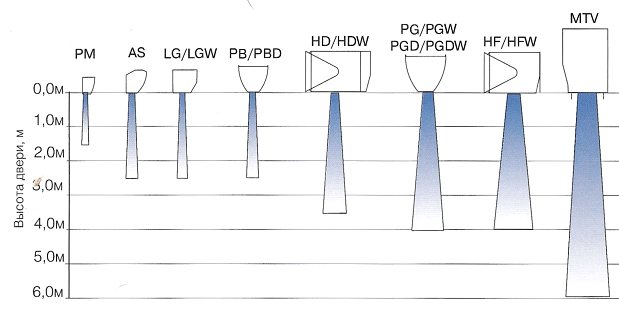

According to the method of installation, thermal curtains are divided into horizontal and vertical. The most common type is horizontal curtains. They are installed above doorways and create an airflow from top to bottom. If the doorway is wide, then several devices are used that are attached to each other. When, for some reason, horizontal installation is not possible, a vertical heat curtain is used, installed on the side of the doorway.
Its height should be at least 3/4 of the height of the doorway. You should be aware that horizontal air curtains must not be installed in a vertical position, this will lead to their quick breakdown. If there is a need to change the position of the curtain, then there are universal models suitable for both horizontal and vertical installation. Concealed curtains are also used, which are installed behind the suspended ceiling so that only the air outlet grille remains visible.
The air capacity is the volume of air that can be pumped by the heat curtain in 1 hour. It is an important parameter when choosing a model and determining the effectiveness of its work. The air flow rate and the optimal installation height of the device depend on the performance. All thermal curtains can be divided into low-pressure, medium-pressure (for openings up to 3.5 m) and high-pressure (up to 10 m).
Advantages and disadvantages of thermal curtains
We will not take into account powerful industrial air curtains, but will pay attention to small-sized and low-power units powered by electricity.
Let's take a look at their main pros and cons.
Let's start with the positives:
If the width of the passage exceeds the width of the air flow of the heat curtain, then it makes sense to install two units side by side at once. Any gap in the coverage area will greatly reduce the overall efficiency of the system.
- Compactness - for all its performance, air curtains are small in size;
- High performance - thermal curtains can pass a huge amount of air through them;
- Large selection in terms of power - from 1-2 kW and above;
- Excellent customer reviews - everyone who has ever come across thermal curtains knows about their high efficiency;
- Reliable protection against the penetration of dust, smoke, exhaust gases and insects;
- The ability to work in the summer as fans with a very important function - in the summer they will prevent the penetration of heat into the premises.
There are also some disadvantages:
- High energy consumption is typical for all heating electrical appliances;
- Noise - efficient fans installed inside these devices make a noticeable noise, which makes it difficult to use them in residential buildings;
- Heating elements in these units burn oxygen - therefore, the premises must be ventilated.
Despite the tangible disadvantages, it is difficult to do without them.
Selection of electric air curtains
To choose this device, you should take into account the specifics of the room. It is necessary to pay attention to the following parameters when choosing an electric heat curtain:
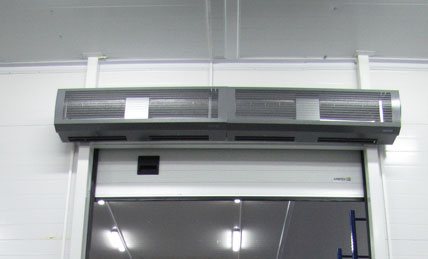

- Width. Here, the choice is quite simple - the width of the curtain created by the device should be larger than the insulated opening. If the width is insufficient, gaps will appear at the edges of the opening, through which heat will be lost. Curtains with a width of 1 to 2.3 m are offered on the market, so you can easily find a device with the required width. If the curtain needs to be installed on a large width, then several devices are placed.
- Power. This parameter is responsible for the overall efficiency of the air curtain installation. The power of the electrical circuit of the thermal curtain and the performance dependent on it are measured, showing the volume of air that passes through the device per unit of time. Productivity is usually expressed in cubic meters per hour. For industrial or warehouse buildings in which the size of the openings is large enough, the most powerful devices should be used.
- Air speed. It affects the vertical efficiency of the curtain and depends on the fan power. The higher the air velocity, the better the device insulates the interior from external influences. The speed affects the possible height of the device. It must be borne in mind that the speed of air movement falls towards the floor, so the device of insufficient power cannot cover the entire opening vertically. There will be a gap at the bottom, and cold air can get into the room. However, excessive fan power is also undesirable, otherwise it will create more draft. This is especially true for small spaces.
- The type of electrical heating element. This parameter may be more important than thermal performance, since electric curtains are not full-fledged heating devices. Cheap models are equipped with heating coils that consume a lot of energy and have a relatively low efficiency. Heat curtains with a tubular heating element are more efficient. Despite the increased price, during long-term operation it will certainly pay off due to lower energy consumption.
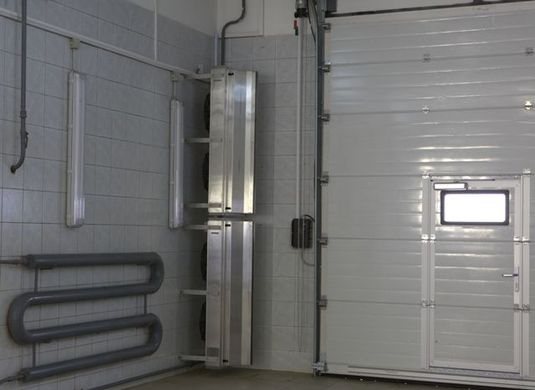

- Control method. The vertical electric heat curtain can have a remote control system. The integration of the electronic control unit into the central building management system is also quite effective. Models with full functionality should be able to separately control the fan and heating system. The use of a curtain without air heating is possible in the summer, which will protect the room from the heat of the street and keep the air cooled by the air conditioner inside. It is also recommended to pay attention to devices that have the ability to change the intensity of heating. In such devices, a thermostatic unit is installed that turns off the heating when the required temperature is reached.
- Fan device.If a device is required that creates a heat curtain more than a meter wide, then the type of turbine that sets the air in motion should be clarified. Solid turbines, which operate along the entire length of the body, are more efficient. In this case, the engine is located on the side. There are devices in which the engine is in the middle, and the work is performed by two fans, which are placed on the sides. The disadvantage of this arrangement is the presence of a gap in the upper part of the curtain, through which heat can be lost.
Calculation of the thermal curtain
Let's talk about calculating a thermal curtain for a home. The main parameter is the height of its suspension - the required initial speed depends on it. The thing is that on the opposite side (near the floor, when installing equipment above the doors), the air flow rate should be 2-3 m / s. If this indicator is less, then the outside air will be able to penetrate into the room - the heat curtain will only waste electricity. If the performance is too high, then the heat will fly out.
An incorrectly selected model, at best, may simply not give a positive result. And at worst, it can also aggravate the situation.
The initial speed directly depends on the working diameter of the fan. For example, with a diameter of 180 mm, the initial speed will be 15 m / s. With regard to power, it all depends on the area of the room and performance.
The optimal performance indicator for doorways 800-1000 mm wide and 2000-2200 mm high is from 700 to 900 cubic meters. m / hour, power - 6 kW (a little more is possible). For a more accurate calculation of all indicators, we recommend using online calculators.
The principle of operation of any thermal curtain
The task of such a protective device is to cut off the outside air with the help of the air itself. Namely - the creation of an insulating air flow that covers the entire open opening. Such a curtain not only retains heat inside the room, but also prevents dust, foreign odors and even insects from entering the outside.
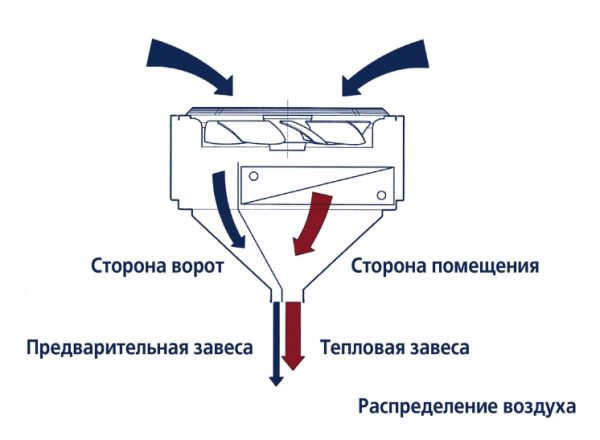

Air barrier
Such devices effectively retain heat where the doors are constantly opening - in shops, garages. And in large country houses, situations can arise when the doors are constantly wide open.
Of course, the purchase of a thermal curtain costs money, and its operation is accompanied by energy consumption. But the effect of keeping warm in a house protected by a curtain allows heating systems to operate at a lower output. This ultimately translates into overall cost savings. In addition, modern thermal curtain devices are equipped with an automatic system that turns on the air barrier only when the door is open, and when the door is closed, the curtain does not work and does not consume energy.
Temperature control
Any heating equipment needs a temperature controller. Otherwise, it will consume too much electricity, obviously overheating the air in heated rooms. The simplest air curtains have built-in thermostats - they analyze the temperature of the sucked in air, turning the heating elements on and off.
A remote thermostat for a thermal curtain is an element of much more powerful devices. It is an electronic or mechanical thermostat that controls the operating modes of the equipment. When the air overheats, it turns off the heating, only the fan works. If the air cools down too much, the thermostat turns on the heating element. There may also be controls for other functions.
Simple household thermal curtains use simple infrared remote controls.
Heating curtain power
In addition to cutting off the outside air, the heat curtain can also heat the indoor air.For approximate calculations, it can be assumed that for heating 10 square meters of an unheated room, with a ceiling height of 2.8: 3.0 meters, 1 kW of power is required. At the same time, it is believed that the walls and ceiling of the room have good thermal insulation (capital building), since it is almost impossible to heat a temporary structure (iron stall, hangar) - heat will go through thin walls. If the curtain is supposed to be installed in a well-heated room, then the heating function is not necessary, and you can choose a model with a minimum power, or a so-called air curtain - without a heating function. Note that the protective properties of the air flow are determined only by the speed of the air and are in no way related to its temperature, therefore, the power of the curtain is an additional, not the main characteristic.
Another important characteristic of thermal curtains is the type of heating elements: heating element or spiral. The spiral heater is a metal wire wound into a spiral. Such heating elements were used in well-known domestic heaters - plates. Significant disadvantages of spiral heaters are the high heating temperature (due to the small surface area), leading to combustion of oxygen and a short service life. A more preferable and more expensive option is a heating element. It is a heating element (made of graphite or wire) placed in a hollow metal tube with a diameter of about 1 cm. The free space inside the tube is filled with quartz sand, which has a high thermal conductivity. As a result, the area of the heating element is significantly increased, which leads to a decrease in the operating temperature. To further increase the area of the heating element, a metal strip is wound around the tube - outwardly it looks like a miniature round heating radiator. Such a heating element is called finned. Finned heating elements are the most preferable option for a heating element of a heat curtain due to their durability and safety for health.
All curtains with a heating function have one feature - at the exit of even a very powerful curtain, the air will only be warm and never hot. For example, the temperature difference at the inlet and outlet of a Frico AC210 curtain with a power of 10 kW does not exceed 21 ° C. This paradox is explained by the high blowing speed of the heating elements, so the heat curtain cannot be compared with a heat gun or a fan heater, where the blowing speed is several times lower, and the air temperature, respectively, is higher.
Choosing a thermal curtain - the main criteria
Next, we will consider how to select a thermal curtain. As we said, the first two metrics are suspension height and performance. You also need to pay attention to the maximum dimensions of the doorways. If the heater is to be used as auxiliary heating for residential premises, its power should be 20-40 W per 1 sq. m. Here we can use any suitable model.
Having such a thermostat, you can remotely and with an accuracy of a degree adjust the operation of the device.
We also pay attention to the way functions, temperature and performance are controlled. More convenient units with remote controls - wired or wireless. Thanks to this, you will be able to adjust the parameters of the equipment from a more convenient place. External thermostats are sold separately in most cases.
The type of installation is determined individually - in households where low-power air curtains are traditionally used, horizontal models are most often installed. As for the vertical units, they are focused on use in commercial and industrial premises.
As for brands, here we recommend taking a closer look at foreign-made thermal curtains for a home. There are also quite good domestic units on sale - as an example, we will give heaters of the Tropic and Teplomash brands.
We also pay attention to the following details:
- The ability to work as a fan - useful in the summer;
- The presence of a thermostat - will maintain the set temperature and save energy;
- Overheating protection - will provide equipment protection;
- Noise level is an important parameter for home use, because the house should be quiet;
- Mounting type - wall or ceiling.
The right choice will ensure reliable, stable and trouble-free operation of the equipment.
You can familiarize yourself with the descriptions of certain models in our review - we will consider the most popular units. You can also take a look at the product aggregator
Thermal curtain length
Air-heating curtains have a length of 600 to 2000 mm. The most widespread are devices with a length of 800: 1000 mm, intended for installation above a standard doorway. The length of a properly selected curtain should be equal to or slightly larger than the width of the opening, since only in this case the air flow will completely block it and prevent cold air from getting inside. If the opening is very wide (more than 2 meters), then several devices should be installed close to each other.
Most popular models
If you are planning to buy a thermal curtain, the information from our review will come in handy. Let's take a look at the top-rated devices with you and describe their technical characteristics.
The power of the heat curtain is 3 kW, so this unit can well be used to heat apartments and private houses. Also, the heater is useful in technical and utility rooms - these are workshops, garages, outbuildings and much more. The price of the heater varies from 3.5 to 5 thousand rubles.
Evgeny Filimonov
Ask a Question
The air curtain has a capacity of 350 cubic meters. m / h, installation height - 2.5 m. The power stepwise adjustment is provided - 1500 or 3000 W at the choice of the consumer.
The main advantage of this heater is its attractive design, which makes it suitable for use in residential buildings.
When choosing a low-power thermal curtain, be sure to pay attention to this model. It is intended for use in private houses, outbuildings and outbuildings, in garages and small shops. Its power is 2 kW, productivity is 300 cubic meters. m / hour. The device is designed for horizontal wall installation at a height of 2.5 m. The control here is built-in, mechanical. Operation as a simple fan is possible. The noise level is only 45 dB - this is a fairly low-noise thermal curtain.
One of the simplest heat curtains. The model is far from being intended for domestic use, since it is distinguished by high power and productivity - 4.5 or 9 kW, 840 cubic meters. m / hour. Possibility of operation in simple fan mode is provided. The fact that this device is not for home is also evidenced by its appearance - somewhat "clumsy" and angular. The maximum installation height for this model is 2.2 m. There are only two controls on board - a general switch and a power selection switch.
Before us is another rating heat curtain with a capacity of 9 kW. The capacity of the unit is 900 cubic meters per hour; it is intended for installation in shops, supermarkets, production and storage facilities. There is a power control system on board, it is possible to work in ventilation mode.Despite the impressive power, the unit is compact and lightweight.
Common parameters
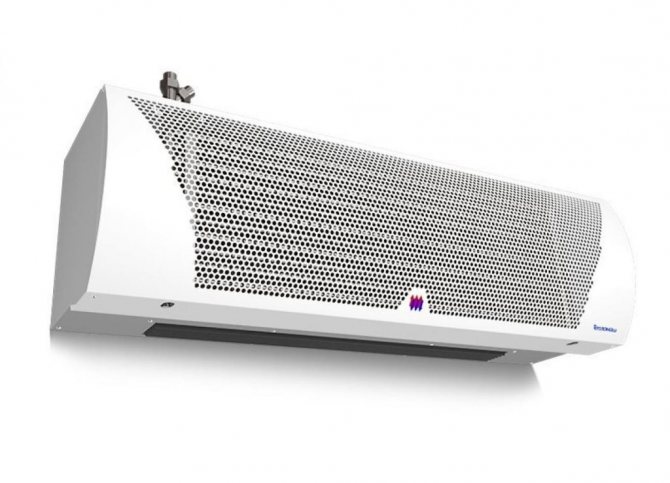

Portable heat curtain
Having set yourself the task of how to choose a thermal curtain, you must first of all take into account six main factors that affect the functionality of the purchased equipment.
- Dimensions of the device.
- Performance.
- Installation method.
- The type of heating element, on which the total power directly depends.
- Coolant type.
- Control method.
Based on this, it will be possible to navigate both the price and other parameters. So, in order:
Dimensions (edit)
The product line implies different sizes that can be enclosed in a fork from 70 cm to 2 meters in length. Focusing on standard doorways, over which, in most cases, thermal curtains are installed, the most popular size has recently become 80-100 cm.Choosing a device, you need to remember two nuances:
- The length of the device must match or even slightly exceed the width of the doorway. If this rule is not observed, then you get the effect of a loosely closed window, which constantly lets drafts inside.
- If the doorway is too wide, it is recommended to install two or more devices in a row on the same line and as close to each other as possible.
Performance
The second criterion that you should definitely pay attention to in order to correctly select and install a thermal curtain for a home, store, production hall and other residential and work premises is productivity. It is he who provides the speed of movement of warm air from the device, and there is only one criterion: the higher the device is installed above the door or gate, the more performance it should have.
Using the example of a standard doorway, the dimensions of which are close to 1 m in width and 2 m in height, we will make the necessary calculations. The productivity of the product for such a door must be at least 900 cubic meters / hour. At the top, the air flow speed will be equal to 8-9 m / s, at the bottom 2-2.5 m / s, which will ensure complete overlap of the entire opening by the air veil.
Heat carrier type
According to this indicator, the devices of the heat curtain are divided into three types: gas, water and electric. Each of them should be considered separately and in more detail.
Gas
Two aspects should be noted at once. Devices of this type are, on the one hand, the safest and with increased efficiency, which reaches almost 100%. On the other hand, they are the most expensive. They run on propane and are used only in large rooms.
Water
The most rarely used option. This is due to the fact that this heat curtain can be mounted only in the immediate vicinity of the hot water supply system. However, for large industrial premises, it is recommended to use this particular type because of its increased power and significant energy savings during operation. But the stability is not very good. This does not apply to the device itself, but its functioning will completely depend on the supply of hot water, which sometimes leaves much to be desired.
Electric
The most popular thermal curtain for the front door, window openings, garage doors and other places where this device is needed. Correctly selected and wisely installed, it will not cause any difficulties in management. In addition, any specialized store offers a fairly wide selection of these devices at fairly affordable prices. The only relative drawback that should be noted is the significant power consumption during operation, which can lead to financial losses.
Heating element type
The main task of the device is to separate the heated air inside the room from the cold streams that tend to penetrate outside. It would seem that the device does not need its own heating element, and in well-heated rooms, a thermal curtain is often used without turning on the heating. However, where the front doors are constantly opening, the hot air shroud does the job much better than just a stream of cold air. Well, the types of heating elements can be of two types:
- Spiral. It is a thick nichrome wire coiled into a spiral. Something like an ordinary household boiler. It has a rather short service life, heats up very much and requires a lot of electricity.
- Heating element. Much more expensive than its spiral competitor, but this is more than offset by the increased service life and absolute safety. It consists of a graphite rod placed in a steel tube filled with quartz sand.
Control
The simplest household model of a heat curtain plugs into a regular electrical outlet and has three built-in buttons.
- Turn on the device.
- Turn on the fan.
- Turning on the heating element.
This is quite enough to easily and easily adjust the selected device. However, the engineering thought does not stand still and more modern models also have additional control functions.
- Heating temperature regulation.
- Adjusting the air flow rate.
- Adjusts the air flow angle.
- On and off timer.
- Built-in thermostat control.
The most advanced models are equipped with sensors that react to the position of the door and even to the speed of the external air flow. There is no point in using such systems in residential buildings, but in stores and shopping centers, correctly selected equipment can provide comfort not only to sellers, but also to visitors.
Working principle and installation
The principle of operation is quite simple: a powerful fan creates a high-speed air flow, which forms an "invisible barrier", thanks to such a system, warm air cannot leave the room, but cold air can penetrate into it. The heat source of the water curtain is hot water. It turns out that for the operation of a water-type device, central heating is needed.
It is, of course, difficult to install such equipment, but this cannot be compared with the fact that during operation the overhead costs are low, and the power is very high. The area of application of water curtains mostly extends to industrial buildings that have large openings. The device is indispensable in restaurants, shops and warehouses, that is, those in those places where the doors are opened very often due to the large flow of people.
Installation is usually done above the door. Installation above the opening means that the curtain is horizontal and to the side of the opening it is vertical. It should be remembered that the vertical curtain must be at least ¾ of the height of the opening to be protected. This is the only difference between this type of device and the horizontal one.
How to choose the right thermal curtain
Thermal curtains are designed for protection of heated premises from cold air entering through open doors, gates, working windows. Operating principle These devices are simple: a powerful fan installed inside the curtain creates a high-speed air flow, which forms an “invisible barrier” that does not allow warm air to escape outside, and cold air from entering the room. The veils are usually are established above the door and create a downward air flow. These devices are indispensable in shops, restaurants, warehouses - wherever a large flow of visitors leads to frequent opening of doors.Moreover, a properly selected curtain allows you to keep the door constantly open even in winter and at the same time maintain a comfortable temperature inside the room without additional energy consumption. The curtain can also be useful in summer - if the air conditioner is operating in the room, then the “invisible barrier” helps to keep cool air (of course, when the heating is off), protects against dust and insects.
When choosing a thermal curtain, first of all, you should pay attention to the following parameters:
- Curtain length
- Air capacity ("pumping") and turbine design
- Power and type of heating element
- Curtain control ability (remote control, thermostat)
- Installation type (horizontal or vertical)
- Heat source (electricity or hot water)
Thermal curtain length
Thermal curtains are available in lengths from 600 to 2000 mm. The most widely used devices are 800 - 1000 mm long, intended for installation above a standard doorway. The length of a properly selected curtain should be equal to or slightly larger than the width of the opening, since only in this case the air flow will completely block it and prevent cold air from getting inside. If the opening is very wide (more than 2 meters), then several devices should be installed close to each other.
Air performance
Dependence of the air flow speed on the distance to the nozzle of the heat curtain
Air performance or "pumping" is the main parameter of any curtain.
The air flow rate depends on the performance and, accordingly, the optimal installation height. For example, to protect a standard doorway 0.8 - 1.0 meters wide and 2.0 - 2.5 meters high, a curtain with "pumping" of 900 - 1200 cbm / h is required. In this case, the speed of the air flow at the outlet of the curtain will be 8 - 11 m / s, and at the floor level - 3 - 4 m / s. However, curtains with such "pumping" cost 15,000 - 20,000 rubles, therefore, in order to save money, buyers sometimes install devices with a lower performance, designed to protect openings up to 1.5 meters high (cash register window, goods delivery window, etc.) ... In this case, cold air will penetrate through the lower part of the doorway, and the desired effect from the use of the thermal curtain will be achieved only partially. Note that in the presence of a vestibule, the use of a curtain with a low flow rate can be quite justified - double doors create an additional barrier to cold air and allow the use of a less expensive curtain.
In addition to "pumping", catalogs always contain recommended installation height, component for various models from 1.5 to 6 meters. Although the installation height should be unambiguously determined by the length, width of the nozzle and the "pumping" of the curtain, in the catalogs of different manufacturers different values of the recommended height are given for the same type of model. We advise you to pay attention that domestic manufacturers, as a rule, declare a higher installation height compared to the recommendations of the market leader - Frico. When choosing a thermal curtain, pay attention to the fact that little-known manufacturers, in order to save money, sometimes reduce the width of the nozzle, thus achieving an increase in the air flow rate. However, a narrow air stream will be unstable and a gust of wind will easily destroy it.
Heat curtain turbine
Another important point is design the most important part of the curtain - turbines(a centrifugal fan that creates the required air flow). To create a uniform air flow, a single turbine is needed, located along the entire length of the curtain. In this case, the engine is mounted on the side of the turbine. Since the manufacture of a turbine over 800 mm in length is technologically challenging, some manufacturers use a mid-engine solution with two small turbines on the sides. This allows to reduce the cost of the curtain, but leads to the fact that in the most important - the central part of the air flow, a "dip" is formed. The consequence of this is not only the deterioration of the protective properties of the air flow, but also the uneven blowing of the heating elements, which can lead to their premature failure.
In the conclusion of this section, we would like to emphasize that it is “pumping”, and not power, that is the most important parameter of the heat curtain. The cost of the curtain also directly depends on its "pumping" and length, at the same time very little depends on the power. And what the power affects, we will tell further.
Heating curtain power
Use of high-performance thermal curtains to protect a permanently open opening
Besides cutting off the outside air, the heat curtain can also heat the indoor air.For approximate calculations, it can be assumed that for heating 10 square meters of an unheated room, with a ceiling height of 2.8 - 3.0 meters, 1 kW of power is required. At the same time, it is believed that the walls and ceiling of the room have good thermal insulation (capital building), since it is almost impossible to heat a temporary structure (iron stall, hangar) - heat will go through thin walls. If the curtain is supposed to be installed in a well-heated room, then the heating function is not necessary, and you can choose a model with a minimum power, or a so-called air curtain - without a heating function. Note that the protective properties of the air flow are determined only by the speed of the air and are in no way related to its temperature, therefore the power of the curtain is an additional, not the main characteristic.
Another important characteristic of air curtains with is type of heating elements: Heating element or spiral (we mean curtains with an electric heating element, curtains with water heating are discussed below). The spiral heater is a metal wire wound into a spiral. Such heating elements were used in widely known domestic heaters - "plates". Significant disadvantages of spiral heaters are the high heating temperature (due to the small surface area), leading to the "combustion" of oxygen and a short service life. A more preferable and more expensive option is a heating element. It is a heating element (made of graphite or wire) placed in a hollow metal tube with a diameter of about 1 cm. The free space inside the tube is filled with quartz sand, which has a high thermal conductivity. As a result, the area of the heating element increases significantly, which leads to a decrease in the operating temperature. To further increase the area of the heating element, a metal strip is wound around the tube - outwardly it looks like a miniature round heating radiator. Such a heating element is called finned. Finned heating elements are the most preferable option for a heating element of a heat curtain due to their durability and safety for health.
All the veils with heating function there is one feature - at the exit of even a very powerful curtain, the air will only be warm and never hot. For example, the temperature difference between the inlet and outlet of a Frico AC210 curtain with a power of 10 kW does not exceed 21 ° C. This "paradox" is explained by the high speed of blowing the heating elements, therefore the heat curtain cannot be compared with a heat gun or a heater, where the blowing speed is several times lower, and the air temperature, respectively, is higher.
Curtain control method
Any heat curtain has at least two switches - one switches on the fan, the second switches on the heating elements. In addition to this, some air curtains have two- or three-stage heating power controllers and two-speed fans. The control panel can be either built-in or remote (wired). Built-in remotes are used only on small curtains for standard door and window openings, otherwise the buttons will be difficult to reach. The remote controls are used with semi-industrial and industrial curtains - such a remote control can be installed in any convenient place.
A thermostat can be installed in addition to the remote control, which will turn off the heating elements (or the entire curtain) when the set temperature in the room is reached.
Sometimes, to save energy, industrial curtains in hangars or warehouses are controlled by a limit switch. This switch is triggered when the gate is opened (up) and turns on the curtain only while the gate is open. For curtains installed above ordinary doors, this control method is not suitable, since the fan spin-up and heating elements take up to 5 - 10 seconds.
Note that all commercially available air curtains have one, and more often several degrees of overheating protection. Firstly, the heating elements of all curtains are turned on only when the fan is turned on, and secondly, a capillary thermostat is usually installed next to the heating elements, which turns off the power when the heating elements are heated above the threshold temperature (usually from 80 to 110 ° C).
Horizontal and vertical air curtains
Vertical air curtains
Most air curtains are designed for horizontal installation on top of an open opening. However, it happens that such an installation is impossible or impractical. In these cases, a vertical heat curtain is used, which is installed on the side of the opening. Accordingly, the air flow from the vertical curtain will be directed horizontally. Vertical thermal curtains are used in cases where the height of the opening is less than its width. In this case, the length of the vertical curtain will be less than the length of the horizontal heat curtain, which will reduce its cost. In addition, to protect the opening, a thermal curtain with a height of 75 - 80% of the opening height is sufficient (cold air penetrates through the lower part of the opening, so its upper part need not be protected). For wide openings, vertical curtains can be installed on each side of the opening.
Structurally, a vertical heat curtain differs from a horizontal one by the presence of additional bearings at one or two ends of the shaft, which take the weight of the turbine. Depending on the installation location relative to the opening (left or right, when viewed from the side of the room), vertical air curtains are left, right and universal (universal vertical air curtains can be placed on either side of the opening). In addition, there are industrial air curtains that can be installed in any position - vertical and horizontal.
Electric and water heat curtains
In addition to models with electric heating, there are curtains with water supply - water thermal curtains. As the name suggests, the source of heat in such curtains is hot water supplied from the central heating system. The increased complexity of the installation of water curtains is compensated by low operating overhead costs and high power. These curtains are usually used in industrial buildings with large openings. For water heat curtains, a piping unit (pump, bypass, etc.) and an automation system are required to prevent defrosting of the air heater in the cold season.
Main element
The main design element is a radial fan, which is necessary to create the required air flow. Such a turbine should be uniform and located along the entire length of the device. It helps to create an even flow. The engine is mounted on the side of it.
However, manufacturers often choose to center the engine with small turbines on either side. The reason for this arrangement of elements is the complexity of manufacturing a turbine with a length exceeding 800 mm. How effective is this installation method? Of course, such a simplified curtain will cost less, but there will be a "dip" in the central part of the air flow, which significantly reduces the protective properties.In addition, the heating elements will be blown unevenly, and this leads to their earlier breakdown.
Thermal curtain device
Simplified, the operation of a device that creates an air barrier can be represented as a combination of heating elements and a fan. The heated air is driven by a fan, and the outlet ducts and louvers form a wide and flat flow from it, directed along the protected space.
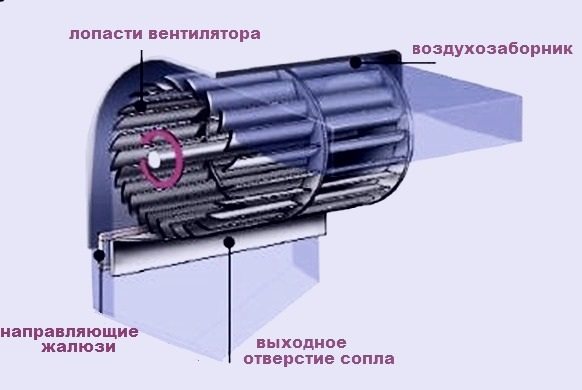

Simplified thermal curtain device
Of course, in reality, everything is not so simple. Conventional axial fans are not suitable for wide and even airflow. Radial and diametrical fans are used to provide a high-quality air barrier. It is a long cylinder in shape, with blades along its entire length.
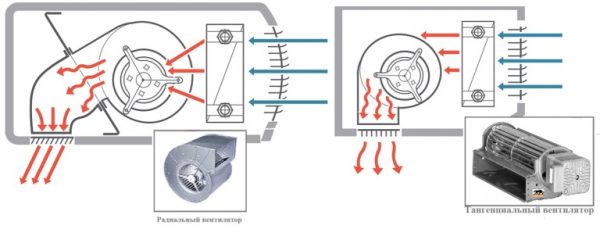

The scheme of work of the thermal curtain
Typically, such a turbine is rotated by an electric motor located on the side. But there are options in which the engine is located in the middle and rotates two turbines on either side of it. Such a design requires a complicated air duct arrangement, since otherwise a narrow section is formed in the middle, in which an air screen is not created.
The features of air protection devices differ in the place of installation, in the type of heating elements and in the control methods.
How is the water curtain controlled?
The water curtain is accompanied by at least two switches, one of which must turn on the fan, and the other must turn on the heating elements. Heating power regulators can also be installed, which have two or three stages. Fans can be two-speed. The air curtain can have a thermostat that turns off the device or heating elements when the set temperature is reached.
There is a built-in and wired control panel, it all depends on the chosen model. However, the built-in type is used on curtains that are small in size, which are installed for windows and doors. This is because the distance depends on the ability to reach the buttons. Accordingly, for water curtains, it is more rational to use remote controls that can be installed in the right place.
Sometimes the use of a limit switch takes place, which is convenient in that it turns on the device only when the gate is open. It turns out that the switch starts to work when the doors or gates are opened. Its use is very convenient in warehouses and hangars.
Curtain selection
The choice of an air curtain is influenced by the following factors:
- Device length.
- Power.
- Performance.
- Type of instalation.
- Control method.
We have already discussed the last two factors, now we will talk about the other three.
- Performance. It is on it that the air flow rate and the installation height depend. For example, let's take a doorway that is about one meter wide and about two meters high. In this case, the "pumping" of the curtain should be from 700 to 900 cubic meters per hour. With such a performance, the air flow rate will be about 8 meters per second at the outlet of the device, and about 2 meters per second at floor level. Of course, the price of such devices is not small, therefore, devices with lower performance are used to protect small openings. Since water curtains are used more for industrial buildings, it is impossible to save on this factor, otherwise the efficiency will be minimal.
- Power is also an important factor when you consider that the equipment can heat the air in the room, although this factor is not at all necessary. For example, let's take a 10 square meter building that is not heated and has a ceiling height of about three meters. The power required under such conditions is 1 kW. However, in this case, the building must be permanent, that is, the ceiling and walls must have good thermal insulation.You should not choose a device with a high power for well-heated places, or even a device without a heating function. It is worth mentioning the peculiarity of the heating function: at the outlet of the curtain, the air will never be hot, even if the power is maximum, it will only be warm. There is an explanation for this: the heating elements have a high blowing speed.
- Length. It can be from 600 to 2000 millimeters. Lengths from 800 to 1000 millimeters are very popular, such devices are installed above a standard opening, therefore they are not suitable for industrial facilities, where water curtains are often used. How to correctly calculate the length in this case? It should be the same as the width of the opening or slightly more. This is important in order for the air flow to completely block the opening and prevent cold air from entering the room. All this information will help you choose the right water curtain, as it plays an important role in creating a comfortable environment. The installation of such equipment will indicate that caring for people is an integral part of any organization.
How to choose a thermal air curtain
When choosing a thermal curtain on your own, it is important to take into account a number of indicators, including: the dimensions of the protected opening, the power of the curtain, the methods of its installation and heating. It should be remembered that only professional suppliers of this equipment will help to take into account all the nuances. Most often, a horizontal heat curtain is installed in the premises. Its length should be equal to or slightly exceed the width of the opening, otherwise cold air will penetrate into the room. If the opening is wider than three meters, it may be necessary to install several curtains one after the other. If installation of a horizontal curtain is not possible, a vertical curtain is installed on the side of the opening. In this case, its height must be at least ¾ of the opening height. An important indicator is the performance of the thermal curtain. It shows how many cubic meters of air passes through the curtain per unit of time (most often an hour). The performance is selected in accordance with the height of the opening: the higher it is, the more efficient the curtain should be. For example, to protect a door with a size of 0.8 * 2.5 m (as in an ordinary apartment), a curtain with a capacity of about 1000 m3 / h will be required, and for a window in a kiosk - only 300 m3 / h. For the convenience of using the curtain, you can additionally install a thermostat and remote control. The thermostat allows you to select and maintain the required temperature in the room, and using the remote control, the necessary parameters can be set without leaving the workplace. It is advisable to check with the supplier about the presence of a thermostat and a control panel, since not all goods are assembled in this way. As mentioned above, the curtains differ in power and can be used as an additional source of heat. Each square meter of unheated space requires 100 watts of equipment power. For example, an unheated store with an area of 25 m2 requires a 2.5 kW curtain. Experts do not recommend buying curtains with more power than required for these conditions, as this can lead to the opposite effect - loss of heat. If the curtain is installed in a well-heated room, then it is worth choosing a model with a minimum power or no heating function at all. The specialists of the company supplying the air curtains will select the equipment model that will best suit your needs. However, for this it is necessary to accurately and in detail describe the conditions in which the thermal curtain will be used.
Select air curtains on TopClimat .ru
Discuss air curtains with the HVAC community

